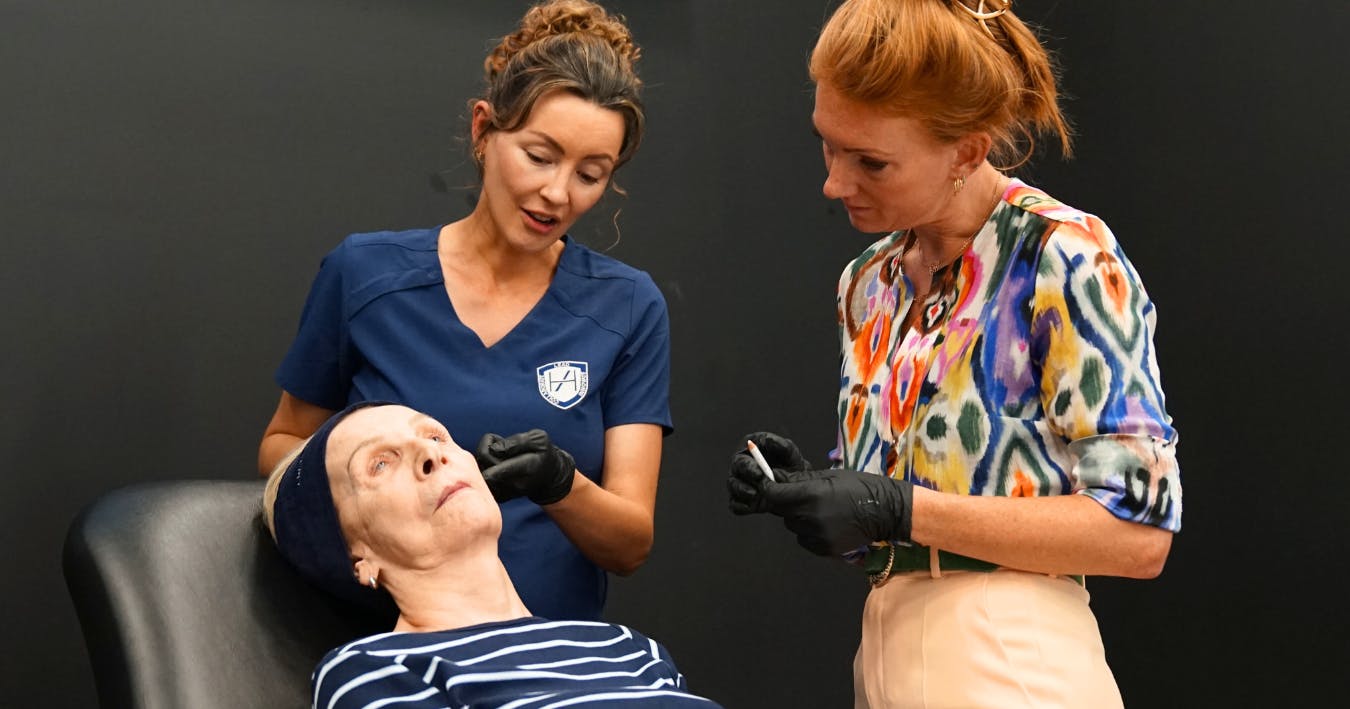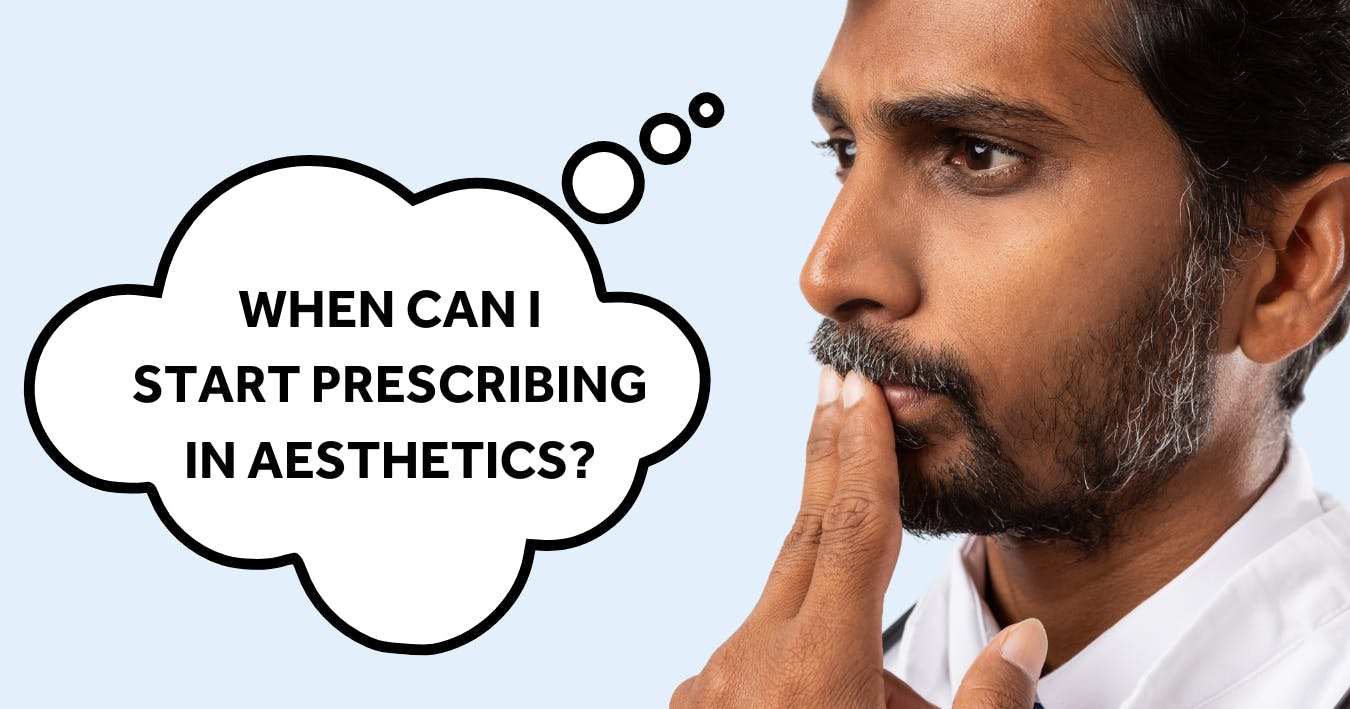As a Medic, When Can I Start Practising Aesthetic Medicine?

“When can I start practising aesthetic medicine?” is one of the most common questions we get from healthcare professionals.
Nurses planning their medical career often want to know if they can start their aesthetics training before getting their PIN. Doctors also regularly ask us if they can take their entry level filler and botox course before qualifying.
We spoke to Dr Marcus Mehta, Chief Marketing Officer at Harley Academy and co-founder of STORY Clinics and Comma, for all the details!
If you’re a doctor, nurse or midwife wanting to get started in medical aesthetics, you’ll find the information you need below…

Can I start aesthetics training to become a cosmetic injector before I get my PIN, or qualify as a doctor?
“The answer to this should be straightforward; our response is no,” Dr Marcus tells us. “You need to be qualified and registered with your professional regulatory body before you can start aesthetics training at Harley Academy.
“This means nurses need to have their PIN and doctors need to be qualified before they can start medical aesthetics training.
“However, in reality, it depends on who you train with.”
Lack of regulated aesthetics courses
As the UK is notoriously lax and still largely unregulated, technically you take a botox or filler course with someone who trains non-medics.
Dr Marcus notes, “There are many unscrupulous unregulated providers out there charging large sums of money for courses that do not teach you the correct techniques nor basic patient safety.
“Unfortunately, when you first start out, you don’t always know what you don’t know. As such, whilst this could get you started, we strongly advise against undertaking injectables courses which may lead you to think you’re more competent than you actually are.”
This could jeopardize your medical licence given healthcare practitioners are answerable to their medical boards, whereas non-medics are not accountable to any governing body.
JCCP-approved aesthetic medicine training provider
Harley Academy is approved as an aesthetic medicine training provider by the Joint Council for Cosmetic Practitioners (JCCP). Our founder and CEO, Dr Tristan Mehta, developed the Level 7 qualification in injectables and our Level 7 Diploma course is Ofqual-regulated, as well as being JCCP-approved. Being ‘Harley Trained’ offers a quality assurance mark that is widely recognised within the industry.
Dr Marcus explains, “You can apply for our aesthetics courses as soon as you qualify as a doctor or receive your PIN for nurses and midwives. We can, of course, provide you with all the advice you need on starting your aesthetic medicine career ahead of this. That way, as soon as you qualify or receive your PIN, you’ll be able to get started straight away!”
We only train medical professionals from the following professions, who are registered with the listed regulatory bodies.
- Doctors - General Medical Council (GMC)
- Dentists & Dental Therapists - General Dental Council (GDC)
- Nurses & Midwives - Nursing & Midwifery Council (NMC)
- Clinical Pharmacists - General Pharmaceutical Council (GPhC).

What you can do to prepare for your aesthetics career before getting your PIN or being qualified
Work your way through this list to ensure you tee up your aesthetics career for the best possible start as soon as you meet the entry requirements…
1. Work out what you want from your aesthetic medicine training
Ask yourself questions that will lead you to the best aesthetics course options for you.
- Do you just want to dip your toes in with a short course or are you fully committed to a postgraduate level education? Maybe somewhere in the middle?
- Do you want to be a certified or qualified aesthetic practitioner?
- How much time do you have to commit to your aesthetics training?
- What is your budget for your course?
- Do you want to concentrate on the core injectables with a botox and filler course, or would you prefer a more holistic approach including skin treatments?
2. Explore medical aesthetics courses
Check out various medical aesthetics courses online. Speak to the training providers of the ones you’re interested in and get a feel for what they offer.
Ask them about the delivery of their courses and get to know the key differences between providers. For example, at Harley Academy, our filler and botox course trainees treat real patients during personalised mentoring sessions, where the patients are provided by us. This allows you to experience full treatment cycles from consultation through treatment to aftercare advice.
Attend open evening events, visit their campuses, talk to other trainees and check their online reviews to get a more rounded picture. Anyone can tell you they’re great but what do people who’ve been there and completed training feel?
3. Start networking with the aesthetic medicine community
Attend events and conferences, such as CCR at ExCel in London, which is free and held every October. Follow community members on social media and join virtual platforms such as Comma, the online Community for Medical Aesthetics.
Make connections and ask practitioners about their journey - where would they recommend? What advice do they have for a fellow healthcare professional just getting started in aesthetics? Most will happily share their story and tips with you!
4. Choose the course you want to do
Once you’ve done your research and decided on the right course for you, see if the training provider can reserve a place for when your PIN arrives.
If they can, you can get that date in your diary then start scheduling time to complete pre-course elements such as eLearning.
How long after getting my PIN can I start practising aesthetic medicine?
“Technically, you could be up and running in as little as a week!” shares Dr Marcus.
“Due to the aforementioned lack of aesthetics regulation, you can currently gain the insurance you need to start practising cosmetic injectables after completing a one-day course.
“We strongly recommend you do not start practising unsupervised straight away, however.
“After a one-day filler and botox course you’re unlikely to have the confidence and competency to treat patients on your own.
“Whether you decide to pursue additional training to build how comfortable you are administering them or find a mentor to practise under, it’s a little unrealistic to consider starting to offer injectables as a sole practitioner after one day of practical training. It’s absolutely legal - at present, though this is likely to change when the aesthetics licensing scheme comes in - but inadvisable.”
He counsels, “If you want to start practising solo, we advise taking a course which provides more than one day of practical training. Ideally, you should also look for tailored, high quality mentoring to ensure you fully experience every aspect of providing treatments.”

Recommended aesthetics training pathways
Depending on your goals and desired career path, if you want to get started as soon as possible after becoming qualified or getting your PIN, these are our recommended aesthetics courses…
Dr Marcus highlights, “It’s worth noting that trainees on any of these courses treat real patients under the guidance of our approachable and knowledgeable faculty. You’ll always have your patients provided by us, to treat exactly as if they were coming to see you in a regular clinic. You just have the added benefit of your mentor supporting you throughout.”
Get going quickly with 2 or 3 days of practical injecting
The Aesthetics Accelerator is a great springboard for your career as a cosmetic injector. It provides a wealth of online theory and digital assets, maximising your learning whilst minimising your travel time. However, it also provides two days-worth of practical mentored injecting sessions.
You’ll treat a number of patients under the expert guidance of our clinical trainers and experience the full treatment cycle, from consultation through treatment to aftercare advice. It’s an incredible experience - just like working in a busy London aesthetics clinic but with the safety and comfort of having a supportive mentor by your side.
This is a certified aesthetics course and you’ll be able to obtain the insurance you need to become a cosmetic injector upon successful completion of your first day of practical training.
If you want to add some targeted aesthetics training on, you can opt for The Aesthetics Accelerator+ which combines the core course with your choice of novice-level Injectables Masterclasses. This provides a further full day of practical training.
Build your client list as you train to a respected, postgraduate’s level standard
Whilst The Aesthetics Accelerator courses are designed to get you up and running quickly, our gold standard, postgraduate level qualification is well worth the extra commitments.
The Level 7 Diploma in Botox & Dermal Fillers offers an Ofqual-regulated qualification in aesthetic medicine. This can be paired with our Cosmetic Dermatology course if you’re looking to take a more holistic approach that includes skin treatments, in our Combined Level 7.
It includes all the Accelerator elements plus more - especially when it comes to injecting! - and takes 12-36 months to complete. However, you can start practising after obtaining your insurance which you can do after receiving your Foundation Training in Botox & Dermal Fillers certificate after your first practical one-day session.
If you’re looking for a filler and botox course with the most comprehensive list of observed cases and hands-on, personalised mentoring, this is the one for you.
These sessions allow you to ask any questions about your clinical cases or acquaintances you may start treating privately to build your confidence. All our mentors are aesthetics specialists in private practice - many with their own clinics - when they’re not teaching at Harley Academy. As such, they have a multitude of invaluable, up-to-date, real world advice to pass on and they’re happy to do so!
This approach allows you to truly specialise in honing your skills in the fundamental filler and botox treatments, with tailored sessions based around your level of comprehension and development.
Upon completion, you’ll be awarded your qualification, allowing you to use the postnominal title, PGDipAes (VTCT). This cements your reputation for completing an outstanding, JCCP-approved aesthetics education at a postgraduate's level - something that can help you to stand out from your competitors.

When can I start prescribing aesthetic medicine treatments?
“Popular aesthetic treatments such as botulinum toxin are prescription only,” Dr Marcus reminds us. “Toxin is usually the first treatment novice injectors offer and use to build their practice with.
“This is largely because there is high demand and it’s a straightforward treatment to administer. It also leaves less room for significant error compared to filler treatments, although whereas hyaluronic acid fillers can be dissolved, you have to wait for the effects of botox to wear off.”
But how do you get hold of your prescription only products once you’re an insured aesthetic practitioner?
“As a cosmetic doctor, you can’t prescribe for your first year of practice,” he tells us. “You have to be an FY2 Doctor - so in your second year of practice - to prescribe.
“If you’re an aesthetic nurse looking to become a prescriber, you’ll need to complete a V300 course. One of the entry requirements for these prescribing courses is usually a Level 7 Diploma in Botox & Dermal Fillers.
“Due to our relationship with the Centre for Appearance Research at the University of the West of England, in Bristol, Harley Academy Level 7 graduates are welcomed onto the V300 course there.
“In the meantime, until you’re able to prescribe, you can work with a prescribing partner or use a prescribing service.”
Next steps
“If you want a bit more background to help you make your decision as to which pathway might be right for you, or even if aesthetic medicine is something you might be interested in, there are two great options I can recommend,” enthuses Dr Marcus.
“First off, book a free place on our online event How to Get Started in Aesthetics. This is where my brother, Dr Tristan and I share all the information you need to know about the industry, the opportunities it offers and how to make a success of your aesthetics career.”
He adds, “We often have special guest speakers - graduates who explain their reasons for moving in to aesthetics from the NHS, whether full- or part-time - and we all answer your questions. So, for an hour of your time, you’ll find out absolutely everything you need to know.”
He adds, “Before that - or after - you can book a call with our Course Advisors. They’re super friendly and knowledgeable and have helped thousands of healthcare professionals with their transition to medical aesthetics. There’s no pressurised selling, it’s just an informal and informative exploration of your options based on what you’re trying to achieve. You can book a call for a day and time that suits you and they can help you to decide on the best aesthetics course based on your current needs.”
We hope this information helps to answer these frequently asked questions but if you’ve got any other queries, let us know! You can pop them in the chat box on the bottom right of this screen and one of our team will get back to you shortly.
All information correct at time of publication
Download our full prospectus
Browse all our injectables, dermal fillers and cosmetic dermatology courses in one document
By submitting this form, you agree to receive marketing about our products, events, promotions and exclusive content. Consent is not a condition of purchase, and no purchase is necessary. Message frequency varies. View our Privacy Policy and Terms & Conditions
Attend our FREE open evening
If you're not sure which course is right for you, let us help
Join us online or in-person at our free open evening to learn more
Our Partners












STAY INFORMED
Sign up to receive industry news, careers advice, special offers and information on Harley Academy courses and services

